Graham Holdings Bundle
Who Really Controls Graham Holdings Company?
Understanding who owns a company is paramount to grasping its strategic direction and potential for growth. For Graham Holdings Company, a diversified entity with roots in The Washington Post, the question of ownership is particularly intriguing. This company, which evolved from its media origins to encompass educational services through Kaplan Inc., television broadcasting, and more, presents a compelling case study in corporate governance.
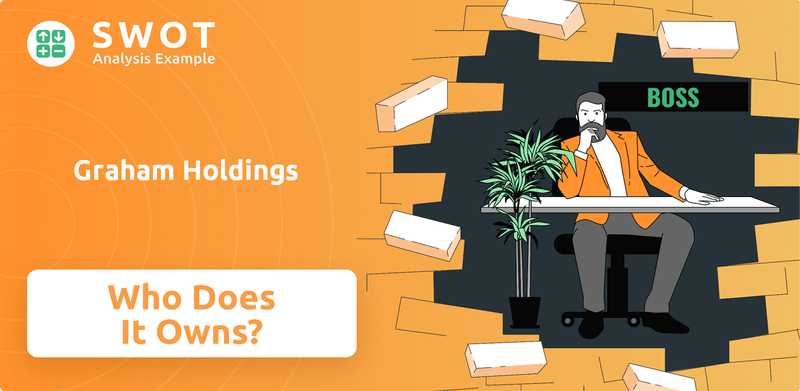
The evolution of Graham Holdings SWOT Analysis, from its inception as The Washington Post Company to its current form, offers valuable insights into its company history and financial performance. Tracing the Graham Holdings ownership reveals a fascinating interplay between public shareholders and the legacy of its founding family, influencing everything from its strategic investments to its operational decisions. Delving into the details of "Who owns Graham Holdings" is key to understanding its future.
Who Founded Graham Holdings?
The story of the Graham Holdings Company owner begins with The Washington Post Company, which Eugene Meyer acquired in 1933. While the original founding of The Washington Post in 1877 involved other individuals, Meyer's acquisition marked a crucial turning point. He brought both financial stability and a commitment to journalistic integrity to the struggling newspaper.
Katharine Graham and her husband, Philip Graham, later took on significant roles. Philip became publisher in 1946, and Katharine assumed leadership after his death in 1963. The Graham family held substantial ownership, ensuring family control and prioritizing long-term goals over short-term financial gains.
The family's vision, particularly under Eugene Meyer and Katharine Graham, directly influenced the concentrated family ownership. This ownership model prioritized journalistic integrity and business stability. The early agreements likely focused on maintaining family control and succession planning within the private ownership structure.
Eugene Meyer's acquisition of The Washington Post in 1933 established the family's foundational ownership. This began the journey of who owns Graham Holdings.
Katharine Graham took over leadership after her husband's death, becoming a major figure in American journalism and business. The family's influence shaped the company's direction.
The Graham family prioritized long-term journalistic integrity and business stability. This vision guided the company's strategic decisions.
The concentrated family ownership model helped maintain control and succession planning. This structure supported the company's long-term goals.
Early agreements likely focused on maintaining family control and succession planning. These agreements were key to the company's stability.
There are no widely publicized records of early ownership disputes or buyouts. This stability allowed for consistent leadership.
The early history of Graham Holdings Company ownership is deeply rooted in the Graham family's leadership and vision. The focus was on building a sustainable business with a strong commitment to journalistic integrity.
- Eugene Meyer's acquisition of The Washington Post in 1933 was a pivotal moment.
- Katharine Graham's leadership solidified the family's influence.
- The family prioritized long-term stability over short-term gains.
- The company's history reflects a commitment to its core values.
- Understanding the Target Market of Graham Holdings provides further insights.
Graham Holdings SWOT Analysis
- Complete SWOT Breakdown
- Fully Customizable
- Editable in Excel & Word
- Professional Formatting
- Investor-Ready Format
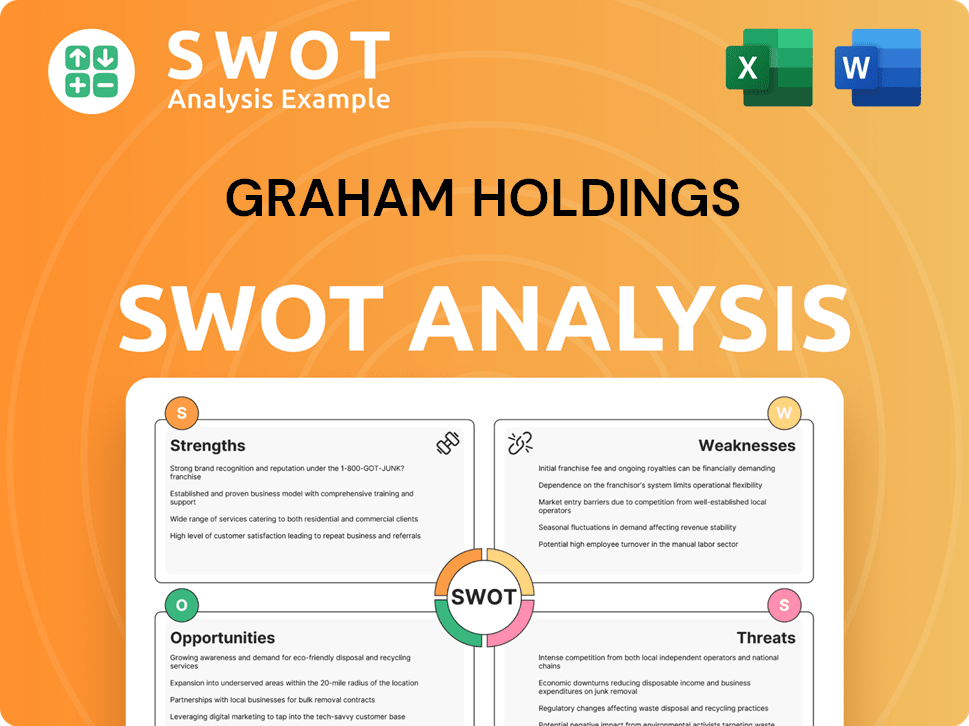
How Has Graham Holdings’s Ownership Changed Over Time?
The ownership structure of Graham Holdings Company has seen significant changes, particularly with its shift from a media-centric business to a diversified holding company. Initially known as The Washington Post Company, it went public in 1971, allowing for wider public ownership. However, the Graham family maintained substantial control through a dual-class stock structure, which is a common method to retain influence in publicly traded companies. This structure allows founders or insiders to hold a majority of voting power, even with a smaller percentage of total equity.
A pivotal moment in its corporate history was the 2013 sale of its flagship newspaper, The Washington Post, to Jeff Bezos for $250 million. This event prompted the company's renaming to Graham Holdings Company, marking its strategic move away from its media roots. Following this sale, the company reinvested capital into its existing businesses and explored new ventures. The company's evolution is a key aspect of understanding the current "Graham Holdings ownership" dynamics.
| Key Event | Impact on Ownership | Date |
|---|---|---|
| Going Public | Broadened public ownership, family retained control via dual-class shares. | 1971 |
| Sale of The Washington Post | Shifted focus away from media; reinvestment in diversified businesses. | 2013 |
| Institutional Investment | Increased stakes held by major institutional investors. | Ongoing (2024-2025) |
As of late 2024 and early 2025 filings, major institutional investors hold significant stakes in Graham Holdings. For example, as of March 31, 2025, Vanguard Group Inc. held approximately 11.2% of shares, BlackRock Inc. held around 9.8%, and State Street Corp. held roughly 5.7%. While the Graham family's direct equity percentage may have decreased over time, their influence often persists through board representation and continued significant holdings. This strategic shift has allowed the company to pursue growth in sectors like education (Kaplan), broadcasting, and healthcare, influencing its overall strategic direction towards diversification and long-term value creation. Understanding the "who owns Graham Holdings" question involves analyzing these shifts and the influence of major stakeholders. For a broader view, consider exploring the Competitors Landscape of Graham Holdings.
Graham Holdings Company's ownership has evolved significantly over time.
- Early public offerings allowed for broader ownership.
- The sale of The Washington Post marked a strategic shift.
- Institutional investors now hold substantial stakes.
- Family influence continues through board representation and holdings.
Graham Holdings PESTLE Analysis
- Covers All 6 PESTLE Categories
- No Research Needed – Save Hours of Work
- Built by Experts, Trusted by Consultants
- Instant Download, Ready to Use
- 100% Editable, Fully Customizable
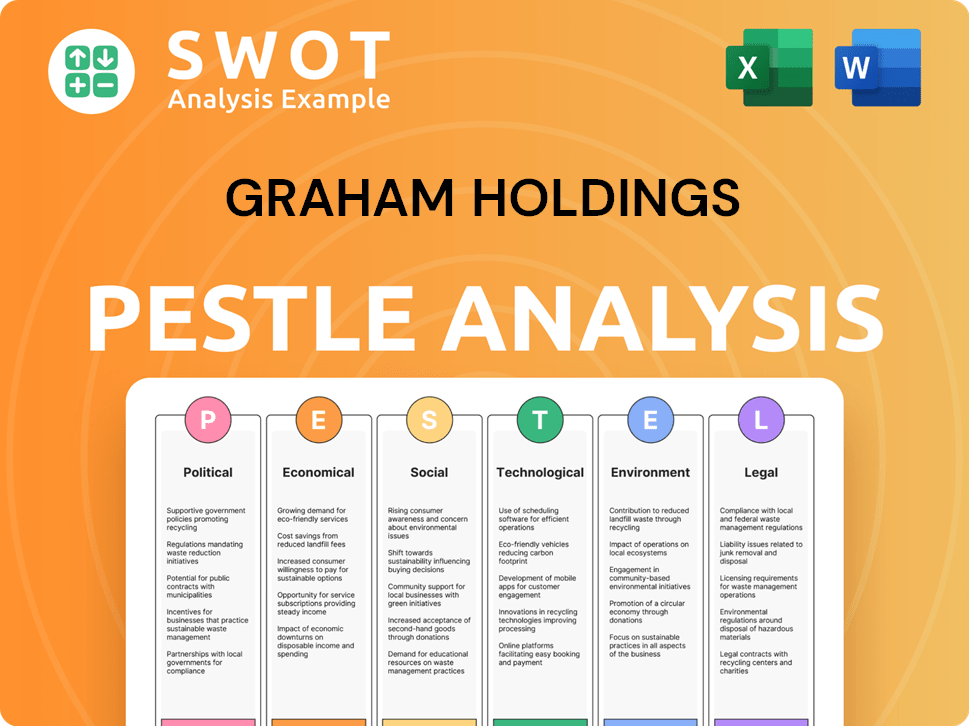
Who Sits on Graham Holdings’s Board?
The Board of Directors of Graham Holdings Company, as of late 2024 and early 2025, is composed of individuals representing a mix of family legacy, major shareholder interests, and independent oversight. Timothy J. O'Shaughnessy, the President and Chief Executive Officer, is a key member, reflecting executive leadership. While specific representation from institutional shareholders like Vanguard or BlackRock isn't always explicitly detailed, their influence is considered in governance matters. The board also includes independent directors who provide objective oversight, representing all shareholders. Understanding the Graham Holdings Company owner is crucial for grasping the company's strategic direction and operational decisions.
The board's composition reflects a balance between continuity and independent oversight, which is typical for companies with a significant family history. The board's role includes overseeing strategic direction, executive performance, and shareholder interests. The company's governance prioritizes stability and long-term strategic execution. For more insights into the company's background, you can explore the Brief History of Graham Holdings.
| Director | Title | Affiliation |
|---|---|---|
| Timothy J. O'Shaughnessy | President and Chief Executive Officer | Graham Holdings Company |
| Donald E. Graham | Chairman of the Board | Graham Holdings Company |
| Hal S. Jones | Lead Independent Director | Independent |
Graham Holdings Company operates with a single class of common stock, where each share generally carries one vote. The historical influence of the Graham family remains significant due to their long-standing involvement and substantial ownership. There have been no recent proxy battles that have significantly altered the company's voting structure or board composition. The Who owns Graham Holdings question is often linked to the family's influence, even without a formal dual-class share structure. Understanding the voting power is essential for investors interested in the company's strategic decisions.
The Board of Directors includes family members, executive leadership, and independent directors. The company's governance structure emphasizes stability and long-term strategy.
- The board oversees strategic direction, executive performance, and shareholder interests.
- The company has a single class of common stock, with each share generally carrying one vote.
- The Graham family's historical influence remains significant.
- The primary business segments include Kaplan Inc. and The Washington Post.
Graham Holdings Business Model Canvas
- Complete 9-Block Business Model Canvas
- Effortlessly Communicate Your Business Strategy
- Investor-Ready BMC Format
- 100% Editable and Customizable
- Clear and Structured Layout
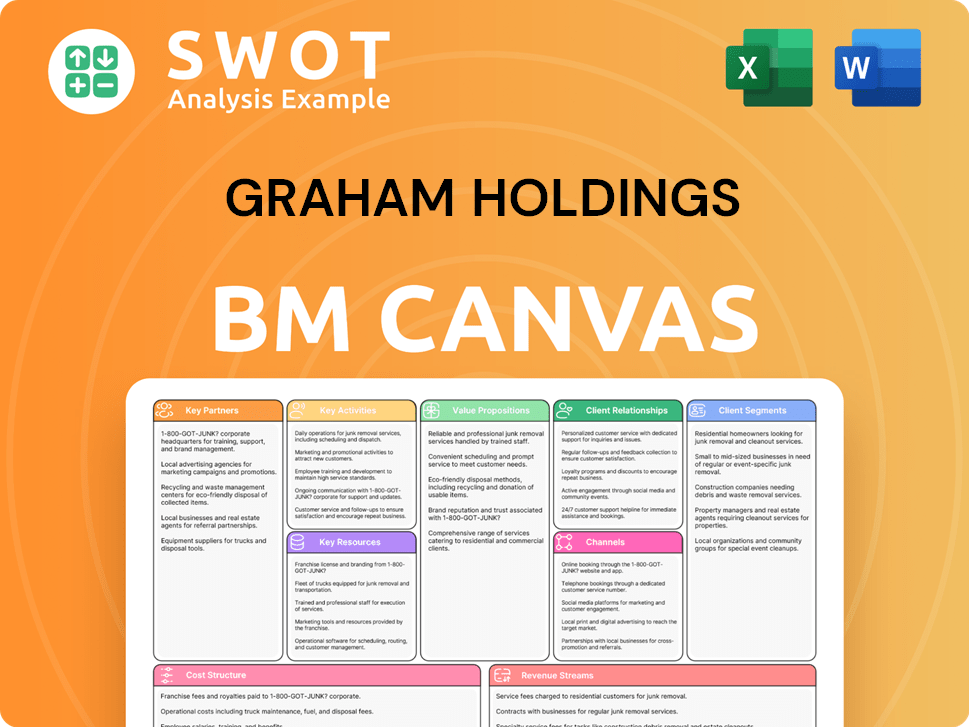
What Recent Changes Have Shaped Graham Holdings’s Ownership Landscape?
Over the past few years (2022-2025), the ownership structure of Graham Holdings Company has seen subtle shifts driven by strategic business decisions. There haven't been any major changes in control publicly announced. The company has focused on refining its portfolio through both strategic divestitures and investments. For example, in early 2024, Graham Holdings sold its automotive dealerships. These actions have indirectly influenced its investor base, reflecting a focus on streamlining operations and potentially attracting different types of investors.
The company's approach to its diverse business units, including education (such as Kaplan Inc.), broadcasting, manufacturing, and healthcare, has been a key factor. While the Graham family maintains a significant stake, institutional investors play an increasingly important role. This means that the collective ownership of large asset managers has a considerable impact on corporate governance and strategic direction. The market has seen a general increase in institutional ownership, and Graham Holdings Company is no exception. The company seems to be concentrating on organic growth within its current segments and opportunistic acquisitions, rather than large-scale ownership changes. For more insights into their financial strategy, consider reading Revenue Streams & Business Model of Graham Holdings.
| Ownership Trend | Details | Impact |
|---|---|---|
| Strategic Divestitures | Sale of automotive dealerships in early 2024 | Streamlines operations, potentially alters investor appeal |
| Institutional Investor Influence | Increased ownership by major asset managers | Greater impact on corporate governance and strategic direction |
| Focus on Organic Growth | Emphasis on growth within existing business segments | Stable ownership profile, opportunistic acquisitions |
The primary owner of Graham Holdings Company is the Graham family, though institutional investors hold a significant portion of the shares. The company is publicly traded, and its ownership structure reflects a mix of family control and institutional investment. This balance influences its strategic decisions and financial performance.
The ownership of Graham Holdings includes both the Graham family and numerous institutional investors. This blend of ownership types impacts the company’s long-term vision and day-to-day operations. The company's diverse portfolio, including Kaplan Inc. and The Washington Post (though the latter was sold in 2013), reflects its varied business interests.
Graham Holdings Company's history includes significant transformations, such as the sale of The Washington Post. The company's financial performance is closely watched by investors, with annual revenue and stock price being key indicators. Investors often look at the company's ability to generate revenue and manage its diverse business segments.
Future ownership trends for Graham Holdings will likely be shaped by the performance of its business units and broader market dynamics. The balance between long-term strategic vision and the interests of its institutional and individual shareholders will continue to be a key factor. The company's ability to adapt and grow will influence its ownership structure.
Graham Holdings Porter's Five Forces Analysis
- Covers All 5 Competitive Forces in Detail
- Structured for Consultants, Students, and Founders
- 100% Editable in Microsoft Word & Excel
- Instant Digital Download – Use Immediately
- Compatible with Mac & PC – Fully Unlocked
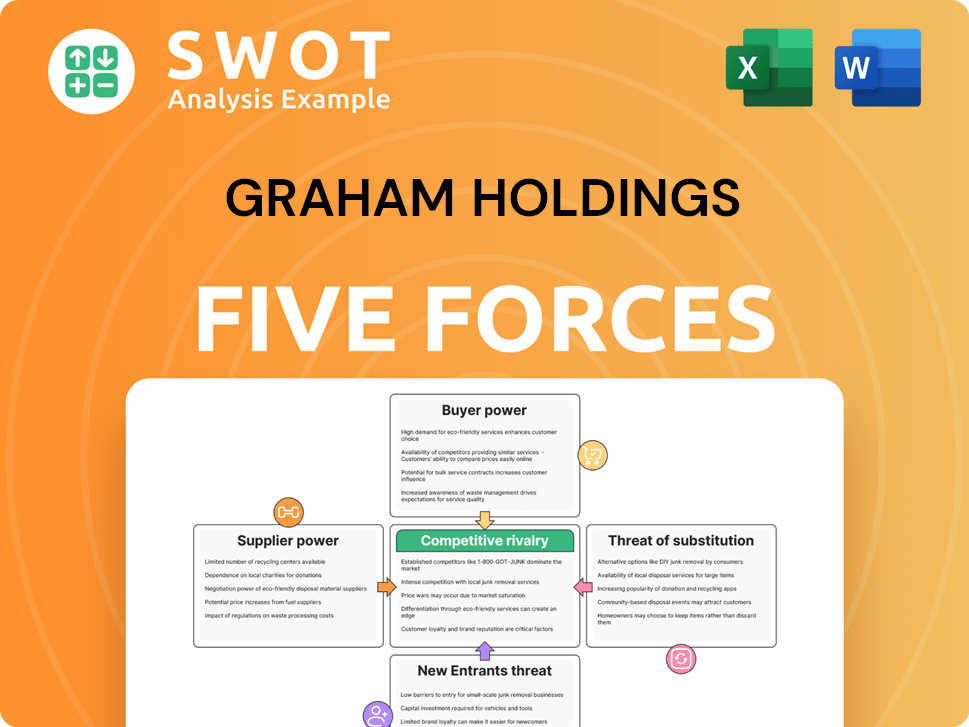
Related Blogs
- What are Mission Vision & Core Values of Graham Holdings Company?
- What is Competitive Landscape of Graham Holdings Company?
- What is Growth Strategy and Future Prospects of Graham Holdings Company?
- How Does Graham Holdings Company Work?
- What is Sales and Marketing Strategy of Graham Holdings Company?
- What is Brief History of Graham Holdings Company?
- What is Customer Demographics and Target Market of Graham Holdings Company?
Disclaimer
All information, articles, and product details provided on this website are for general informational and educational purposes only. We do not claim any ownership over, nor do we intend to infringe upon, any trademarks, copyrights, logos, brand names, or other intellectual property mentioned or depicted on this site. Such intellectual property remains the property of its respective owners, and any references here are made solely for identification or informational purposes, without implying any affiliation, endorsement, or partnership.
We make no representations or warranties, express or implied, regarding the accuracy, completeness, or suitability of any content or products presented. Nothing on this website should be construed as legal, tax, investment, financial, medical, or other professional advice. In addition, no part of this site—including articles or product references—constitutes a solicitation, recommendation, endorsement, advertisement, or offer to buy or sell any securities, franchises, or other financial instruments, particularly in jurisdictions where such activity would be unlawful.
All content is of a general nature and may not address the specific circumstances of any individual or entity. It is not a substitute for professional advice or services. Any actions you take based on the information provided here are strictly at your own risk. You accept full responsibility for any decisions or outcomes arising from your use of this website and agree to release us from any liability in connection with your use of, or reliance upon, the content or products found herein.